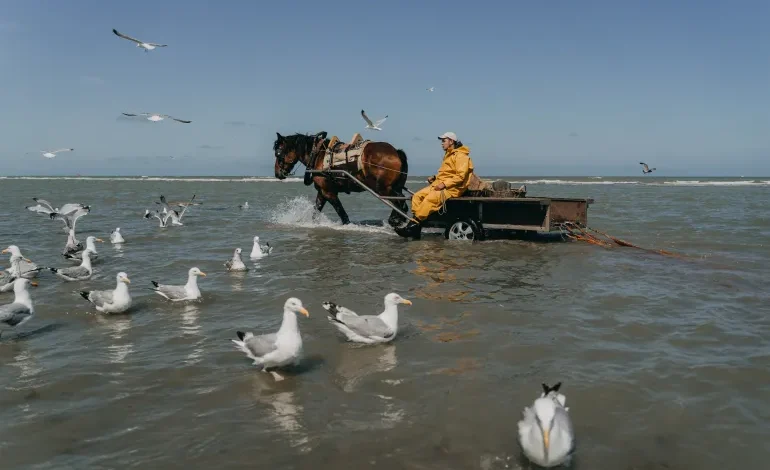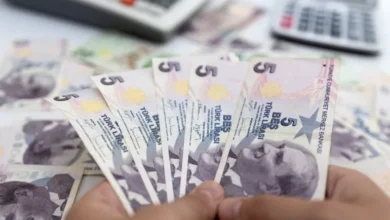‘Kings of the world’: The last of the horseback shrimp fishers

A few hours after dawn one late July morning, the sound of Gregory Debruyne’s horse Kelly trotting through the verdant lanes of Oostduinkerke echoes through the quaint coastal village in west Belgium.
Pulling a cart filled with fishing gear and equipment to sift shrimps, Kelly – a brown Belgian draught horse – and Debruyne are heading towards the sandy shores of the North Sea to go shrimp fishing.
Debruyne is a Belgian horseback shrimp fisherman in Oostduinkerke – the last place in the world where this centuries-old practice of catching shrimp using horses rather than boats continues.
“I learned horseback shrimp fishing from my father when I was 11 years old,” Debruyne, now 27, tells Al Jazeera, as he gets Kelly ready to fish for the day in the village centre, close to the sea.
Dozens of tourists are crowding around them and eagerly watching as Debruyne covers Kelly with a warm blanket and mounts two brown baskets on either side of her back. He also attaches a chained net to her tail.
“Using her hindquarters, Kelly will wade through the shallow waves of the North Sea, until the seawater reaches her chest, pulling the net, which has a chain at the bottom. This pull generates a vibration that disturbs the shrimp in the shallow waters, instigating them to jump into the expanded net,” Debryune explains.
Four other fishermen and their horses have joined Kelly and Debruyne in the village. All the horseback shrimp fishermen don bright yellow anoraks – thick waterproof jackets – and black gum boots and head off towards the North Sea on their horses.
“I hope to return after about an hour, with a worthy catch,” Debruyne shouts back as the spectators watch him and Kelly heading into the sea.
Horseback shrimp fishing – which is on the “Intangible Cultural Heritage of Humanity” list maintained by the United Nations Educational, Scientific and Cultural Organization (UNESCO) – began in northern Belgium at the turn of the 15th and 16th centuries, when the region was under the control of Christian monks.
While it was also practised in the Netherlands, France and parts of southern England, just 12 families in Belgium still pursue the tradition.
In 1502, there was an abbey at Koksijde (in present-day Belgium) and the monks wanted shrimps and fish to eat, something the local religious community was only too happy to oblige. “The local farmers, who owned horses, decided to go to the sea and catch shrimp and fish and give it to the monks of the abbey. This kicked off the practice of horseback shrimp fishing,” Eddy D’Hulster, who worked as a horseback shrimp fisherman for 56 years, tells Al Jazeera.
These days, horseback fishermen like Debruyne also work on commercial vessels to earn more money. On vessels, the horseback shrimp fishers also catch other fish and not just shrimp.
‘Live for the horse and the sea’
Sporting a navy blue cap imprinted with a symbol of a horseback shrimp fisher, 81-year-old D’Hulster is watching the bright yellow anoraks of Debruyne and the other fishermen with their horses out at sea and reminiscing about his first time fishing in such a manner.
“I started fishing for shrimp on horseback thanks to a love story,” he chuckles.
“I met this beautiful girl in the village and learned that her father was a horseback shrimp fisherman. I began learning the tradition from him when I was around 18 years old, seeking to impress his daughter. We were soon married which was great,” he says, blushing.
“But this was also the onset of a bigger love story in my life which always made me feel like the king of the world – horseback shrimp fishing!” he exclaims.
Shrimp caught by the horseback shrimp fishermen in the North Sea are greyish-brown in colour and called brown shrimp. They are found in the shallow waters of the sea and Belgians consider them to be the tastiest shrimp in the world due to their sweet and salty flavour.
“When I started fishing, it was the beginning of spring and the North Sea back then was brimming with brown shrimp,” D’Hulster says. “Treading into the shallow waves of the sea, we could easily catch about 20-30kg [44-66lbs] of shrimp and make a living through this tradition, earning about 30 Belgian francs [about 0.75 euros] for a kilo.”
Today the price is 10 euros ($11.11) for a kilo of shrimp, he says, and “it is the only kind of shrimp I love eating”.
While the catch and the money they could earn was an incentive that drew young men and women in Oostduinkerke to horseback shrimp fishing, D’Hulster says that for many of them, it is also a passion for horses and the “mighty blue” North Sea, which keeps the ancient tradition alive here.
“Shrimps are what we catch, but as a horseback fisherman, you must live for the horse and love the sea. When I started fishing, the thing I loved the best was my horse, Mina. She was about 10 years old and I bought her from my father-in-law. We learned shrimp fishing together,” he says.
Mina died when she was 20 years old, after which it took D’Hulster six months to train another horse to fish.
“Mina taught me to love the open sea. I do miss her, but my family now owns around 10 to 20 horses which are trained to fish in the sea,” D’Hulster says.
Like Kelly, Mina was a Belgian draught horse – a breed trained for agricultural work. The horseback fishers buy horses in big Belgian cities like Brussels and choose the “calmest” ones to accompany them shrimp fishing. Calmness makes it easier to train the horse to tread through the waves of the sea and not to be alarmed by sea creatures in the shallow waters by the shore.
While any horse can be trained to shrimp fish, the Belgian draught horse which is also known as the “Brabant” horse (named after the province in Belgium) enjoys the briny waters of the North Sea and, being bigger, stronger and faster than other breeds, can better help the fishers to carry out their trade efficiently, according to D’Hulster.










